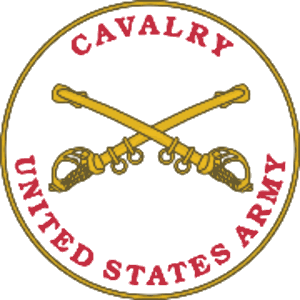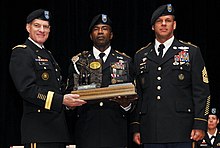
The United States Army (USA) is the land service branch of the United States Armed Forces. It is one of the eight U.S. uniformed services, and is designated as the Army of the United States in the U.S. Constitution. The oldest and most senior branch of the U.S. military in order of precedence, the modern U.S. Army has its roots in the Continental Army, which was formed on 14 June 1775 to fight the American Revolutionary War (1775–1783)—before the United States was established as a country. After the Revolutionary War, the Congress of the Confederation created the United States Army on 3 June 1784 to replace the disbanded Continental Army. The United States Army considers itself to be a continuation of the Continental Army, and thus considers its institutional inception to be the origin of that armed force in 1775.

Military recruit training, commonly known as basic training or boot camp, refers to the initial instruction of new military personnel. It is a physically and psychologically intensive process, which resocializes its subjects for the unique demands of military employment.
Sergeant is a rank in many uniformed organizations, principally military and policing forces. The alternative spelling, serjeant, is used in The Rifles and other units that draw their heritage from the British light infantry. Its origin is the Latin serviens, 'one who serves', through the French term sergeant.

A drill instructor is a non-commissioned officer in the armed forces, fire department, or police forces with specific duties that vary by country. Foot drill, military step, and marching are typically taught by drill instructors.

The U.S. military issues instructor badges to specially training military personnel who are charged with teaching military recruits the skills they need to perform as members of the U.S. Armed Forces or teach continuing education courses for non-commissioned officers and officers in the military. With the exception of the U.S. Army and U.S. Coast Guard, these badges are considered temporary military decorations and must be surrendered upon completion of one's duty as a military instructor. Because of this, the U.S. Air Force, U.S. Navy and U.S. Marine Corps award Drill Instructor Ribbons as a permanent decoration to recognize service members who have qualified and performed as military instructors.

The United States Army Training and Doctrine Command (TRADOC) is a major command of the United States Army headquartered at Fort Eustis, Virginia. It is charged with overseeing training of Army forces and the development of operational doctrine. TRADOC operates 37 schools and centers at 27 different locations. TRADOC schools conduct 1,304 courses and 108 language courses. The 1,304 courses include 516,000 seats for 443,231 soldiers; 36,145 other-service personnel; 8,314 international soldiers; and 28,310 civilians.

Jack L. Tilley is an American businessman and retired United States Army soldier. He served for almost 37 years in the United States Army, culminating in his appointment in 2000 as the 12th Sergeant Major of the Army, a post he held until his retirement on January 15, 2004. He was the last Vietnam War veteran to serve in that position.

Cavalry Scout is the job title of someone who has achieved the military occupational specialty of 19D Armored Reconnaissance Specialist in the Combat Arms branch of the United States Army. As with all enlisted soldiers in the United States Cavalry, the person holding the Scout specialization will still be referred to as a "Trooper", the traditional colloquialism denoted in the cavalry's Order of the Spur.

The United States Army Sergeants Major Academy (USASMA) was established on 1 July 1972 at Fort Bliss, Texas, and began instruction in January 1973. Its curriculum is designed to broaden the student's current knowledge base. This approach differs from the Military Occupational Specialty (MOS) related training at the basic and advanced levels of the Noncommissioned Officer Education System. The prime educational technique employed throughout the course is the small group participatory learning process.

A religious affairs specialist, previously known as chaplain assistant, is a member of the U.S. Army Chaplain Corps. This soldier provides expertise in religious support and religious support operations. The Religious Affairs Specialists, which is military occupational specialty (MOS) 56M, support the unit Chaplain and Commander in responding to the needs of soldiers, family members, and other authorized personnel. They act as counselors for their fellow Soldiers and provide security to Army chaplains. Duties include preparing spaces for worship, managing supplies, and ensuring the security and safety of the chaplain during combat situations.
In many militaries, a platoon sergeant is the senior enlisted member of a platoon, who advises and supports the platoon's commanding officer in leading the unit.

The United States Army Armor School is a training school located at Fort Benning, Georgia. Its primary focus is the training of United States Army soldiers, non-commissioned officers, warrant officers, and commissioned officers in the operation, tactics, and maintenance of armored forces. It also trains for equipment handling including the M1 Abrams, the Bradley Fighting Vehicle, the Stryker Mobile Gun System, assorted crew-served and personal weapons, various other equipment including radios, and more. The Armor School moved to Fort Benning in 2010 as part of the United States Base Realignment and Closure program.

United States Army Basic Combat Training (BCT) is the recruit training program of the United States Army, for service in the U.S. Army, U.S. Army Reserve, or the Army National Guard.

Basic Training in the United States Army is the initial training for new military personnel typified by intense physical activity, psychological stress and the development of social cohesion. The United States Army Center for Initial Military Training (USACIMT) was created in 2009 under the U.S. Army Training and Doctrine Command to oversee training related issues.

The infantry blue cord is a United States military decoration worn over the right shoulder of all infantry-qualified U.S. Army soldiers. It is a fourragere in light blue, specifically PMS 5415, worn under the right shoulder and under the right epaulette of a U.S. Army infantry soldier's Class A dress blue uniform jacket or Class B shirt. The cord is composed of a series of alternating left and right half knots that are tied around a leader cord to form a "Solomon bar".

All branches of the United States Armed Forces use the general term Enlisted Professional Military Education (EPME) to describe the formal system of education which each branch provides to its enlisted personnel. Each branch has its own system and sequence of courses, with the overall focus on leadership and management. Education generally increases in intensity and level of knowledge as individuals progress in rank and assume broader leadership roles. EPME is distinct from the technical training which service members receive for their Military Occupational Specialty (MOS), Air Force Specialty Code (AFSC), or Navy Rating.

The 108th Training Command is a United States Army Reserve unit headquartered in Charlotte, North Carolina. At its activation, the unit was designated as the 108th Airborne Division, but in 1952 was redesignated the 108th Infantry Division. In 1956, the division was again reorganized, this time to the designation as the 108th Division. Under the U.S. Army Reserve Transformation of 2005, the 108th was reorganized to is current structure as the 108th Training Command. The command is currently one of the largest in the Army Reserve, commanding and coordinating 9,000 soldiers.

The Army Reserve Officers' Training Corps (AROTC) is the United States Army component of the Reserve Officers' Training Corps. It is the largest Reserve Officers' Training Corps (ROTC) program which is a group of college and university-based officer training programs for training commissioned officers for the United States Army and its reserves components: the Army Reserves and the Army National Guard. There are 30,000+ Army ROTC cadets enrolled in 274 ROTC programs at major universities throughout the United States.

The Expert Soldier Badge, or ESB, is a special skills badge of the United States Army. Similar in appearance to the Combat Action Badge, the ESB is awarded to soldiers who are neither infantry, special forces, nor combat medics who demonstrate their competence in various warrior and mission essential tasks, land navigation, and physical fitness. The badge was approved on June 14, 2019 and entered service in October 2019, as a way for soldiers in other military occupational specialties to certify their competence within their occupation, as well as general combat skills.

The United States Army's Noncommissioned Officer Candidate Course (NCOCC), originally located at Fort Benning, Georgia, was created to fill the Army's critical shortage of junior noncommissioned officers with the best qualified and best trained men available. NCO Candidates (NCOC) allowed to attend the course were selected from volunteers and many candidates were among the brightest soldiers of Basic Combat Training, Advanced Individual Training or in a subsequent assignment that demonstrated outstanding leadership potential. The program was in existence only during the U.S. war in Vietnam.


















